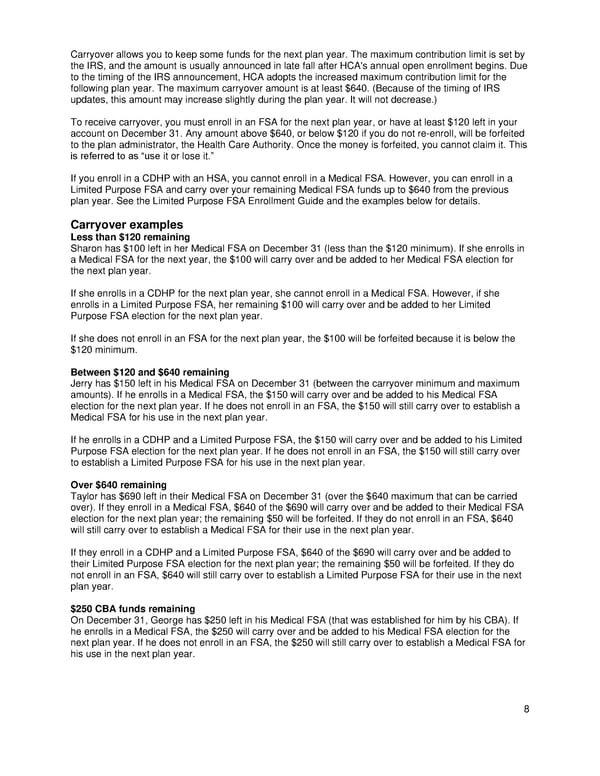Carryover allows you to keep some funds for the next plan year. The maximum contribution limit is set by the IRS, and the amount is usually announced in late fall after HCA's annual open enrollment begins. Due to the timing of the IRS announcement, HCA adopts the increased maximum contribution limit for the following plan year. The maximum carryover amount is at least $640. (Because of the timing of IRS updates, this amount may increase slightly during the plan year. It will not decrease.) To receive carryover, you must enroll in an FSA for the next plan year, or have at least $120 left in your account on December 31. Any amount above $640, or below $120 if you do not re-enroll, will be forfeited to the plan administrator, the Health Care Authority. Once the money is forfeited, you cannot claim it. This is referred to as “use it or lose it.” If you enroll in a CDHP with an HSA, you cannot enroll in a Medical FSA. However, you can enroll in a Limited Purpose FSA and carry over your remaining Medical FSA funds up to $640 from the previous plan year. See the Limited Purpose FSA Enrollment Guide and the examples below for details. Carryover examples Less than $120 remaining Sharon has $100 left in her Medical FSA on December 31 (less than the $120 minimum). If she enrolls in a Medical FSA for the next year, the $100 will carry over and be added to her Medical FSA election for the next plan year. If she enrolls in a CDHP for the next plan year, she cannot enroll in a Medical FSA. However, if she enrolls in a Limited Purpose FSA, her remaining $100 will carry over and be added to her Limited Purpose FSA election for the next plan year. If she does not enroll in an FSA for the next plan year, the $100 will be forfeited because it is below the $120 minimum. Between $120 and $640 remaining Jerry has $150 left in his Medical FSA on December 31 (between the carryover minimum and maximum amounts). If he enrolls in a Medical FSA, the $150 will carry over and be added to his Medical FSA election for the next plan year. If he does not enroll in an FSA, the $150 will still carry over to establish a Medical FSA for his use in the next plan year. If he enrolls in a CDHP and a Limited Purpose FSA, the $150 will carry over and be added to his Limited Purpose FSA election for the next plan year. If he does not enroll in an FSA, the $150 will still carry over to establish a Limited Purpose FSA for his use in the next plan year. Over $640 remaining Taylor has $690 left in their Medical FSA on December 31 (over the $640 maximum that can be carried over). If they enroll in a Medical FSA, $640 of the $690 will carry over and be added to their Medical FSA election for the next plan year; the remaining $50 will be forfeited. If they do not enroll in an FSA, $640 will still carry over to establish a Medical FSA for their use in the next plan year. If they enroll in a CDHP and a Limited Purpose FSA, $640 of the $690 will carry over and be added to their Limited Purpose FSA election for the next plan year; the remaining $50 will be forfeited. If they do not enroll in an FSA, $640 will still carry over to establish a Limited Purpose FSA for their use in the next plan year. $250 CBA funds remaining On December 31, George has $250 left in his Medical FSA (that was established for him by his CBA). If he enrolls in a Medical FSA, the $250 will carry over and be added to his Medical FSA election for the next plan year. If he does not enroll in an FSA, the $250 will still carry over to establish a Medical FSA for his use in the next plan year. 8
 Medical FSA Enrollment Guide Page 7 Page 9
Medical FSA Enrollment Guide Page 7 Page 9